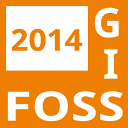FOSSGIS2014 - 45_2014_04_08
FOSSGIS 2014
Konferenz für freie und Open Source-Software im GIS-Bereich und für freie Geodaten
| Referenten | |
|---|---|
|
|
Peter Löwe |
| Programm | |
|---|---|
| Tag | Donnerstag - 2014-03-20 |
| Raum | H2 |
| Beginn | 17:00 |
| Dauer | 00:30 |
| Info | |
| ID | 648 |
| Veranstaltungstyp | Vortrag |
| Track | Vorträge (GIS) |
| Recordings | |
| h264 webm ogg mp3 youtube | |
Scientific 3D Printing with GRASS GIS
A work in progress report

As the amount of scientific data continues to grow, researchers need new tools to help them visualize complex data. Immersive data-visualisations are helpful, yet fail to provide tactile feedback and sensory feedback on spatial orientation, as provided from tangible objects. The gap in sensory feedback from virtual objects leads to the development of tangible representations of geospatial information to solve real world problems. Examples are animated globes, interactive environments like tangible GIS, and on demand 3D prints.
The production of a tangible representation of a scientific data set is one step in a line of scientific thinking, leading from the physical world into scientific reasoning and back: The process starts with a physical observation, or from a data stream generated by an environmental sensor. This data stream is turned into a geo-referenced data set. This data is turned into a volume representation which is converted into command sequences for the printing device, leading to the creation of a 3D printout. As a last, but crucial step, this new object has to be documented and linked to the associated metadata, and curated in long term repositories to preserve its scientific meaning and context.
The workflow to produce tangible 3D data-prints from science data at the German Research Centre for Geosciences (GFZ) was implemented as a software based on the Free and Open Source Geoinformatics tools GRASS GIS and Paraview.
The workflow was successfully validated in various application scenarios at GFZ using a RapMan printer to create 3D specimens of elevation models, geological underground models, ice penetrating radar soundings for planetology, and space time stacks for Tsunami model quality assessment.
While these first pilot applications have demonstrated the feasibility of the overall approach, current research focuses on the provision of the workflow as Software as a Service (SAAS), thematic generalisation of information content and long term curation.
